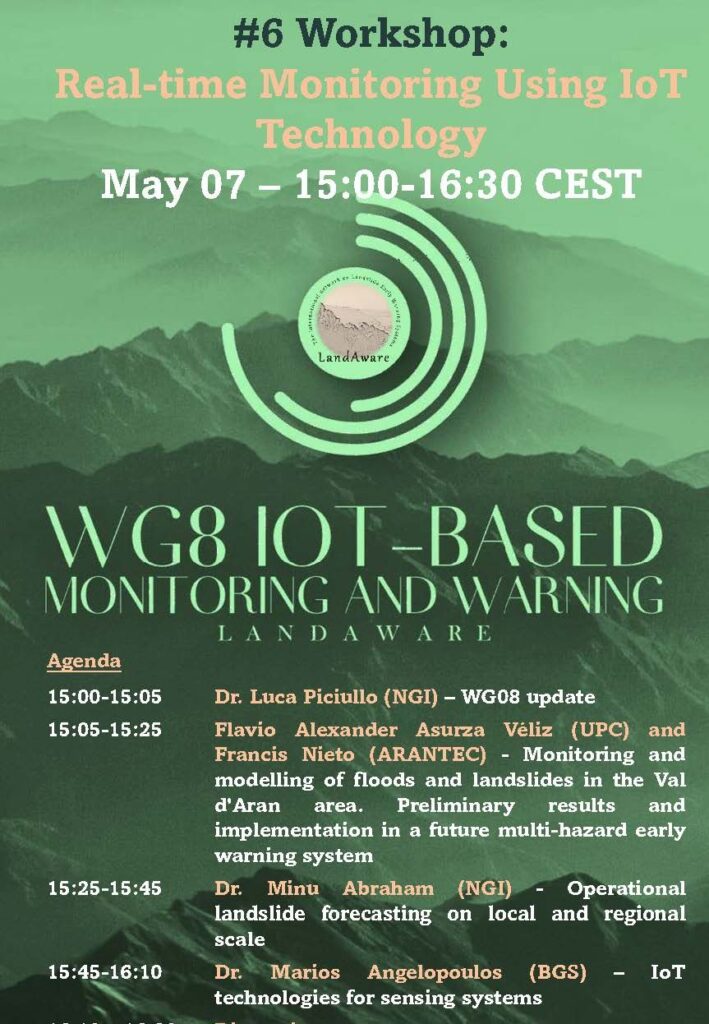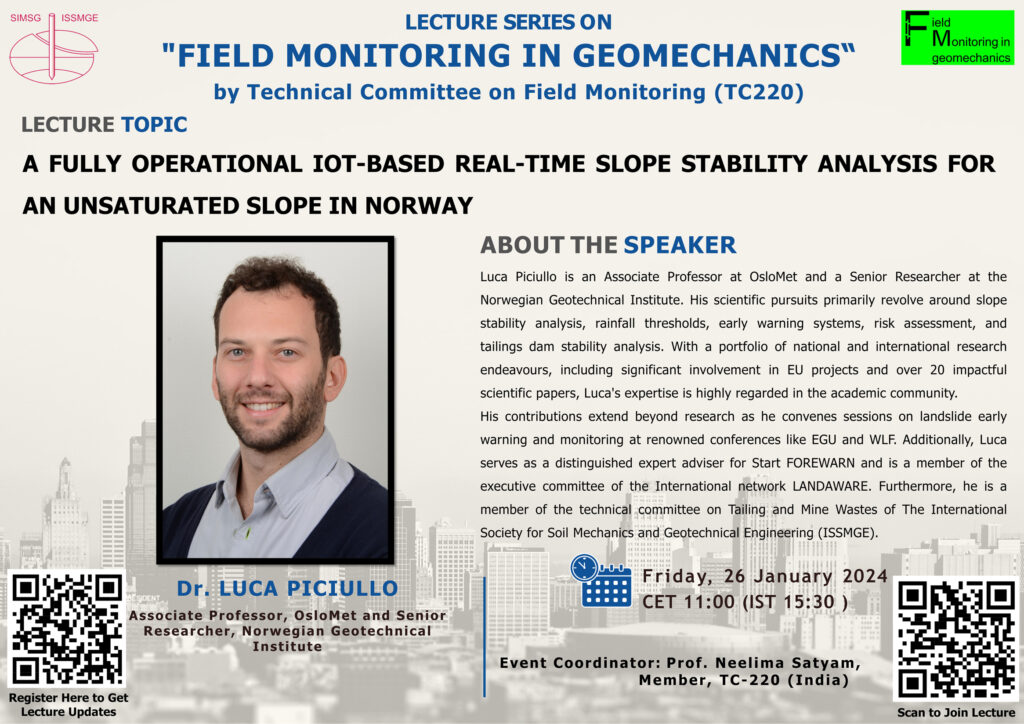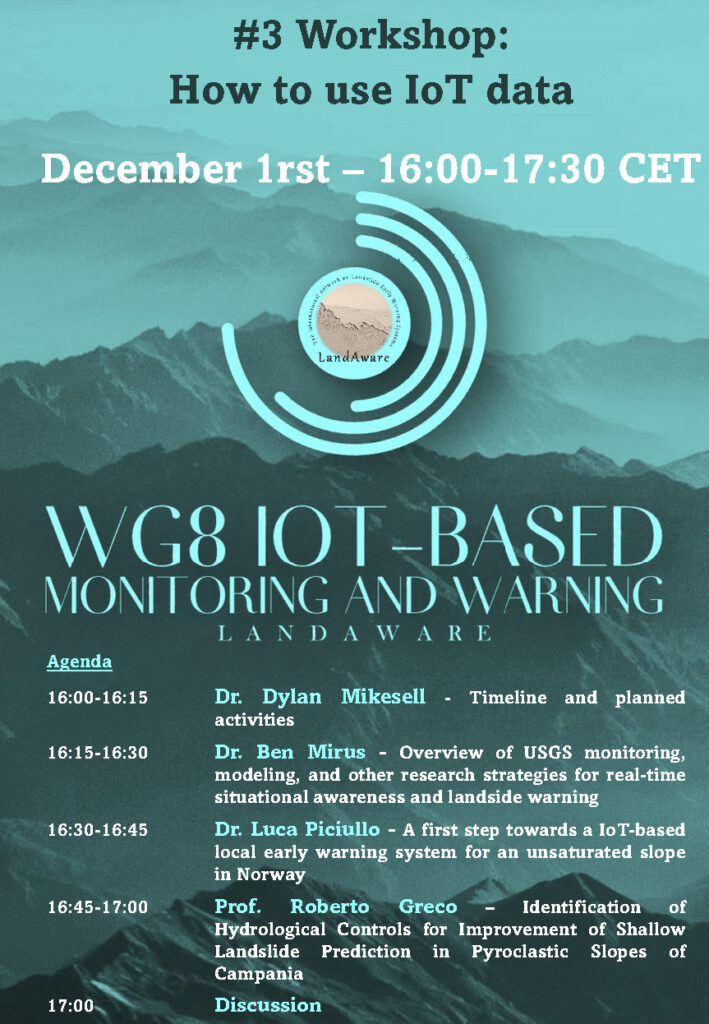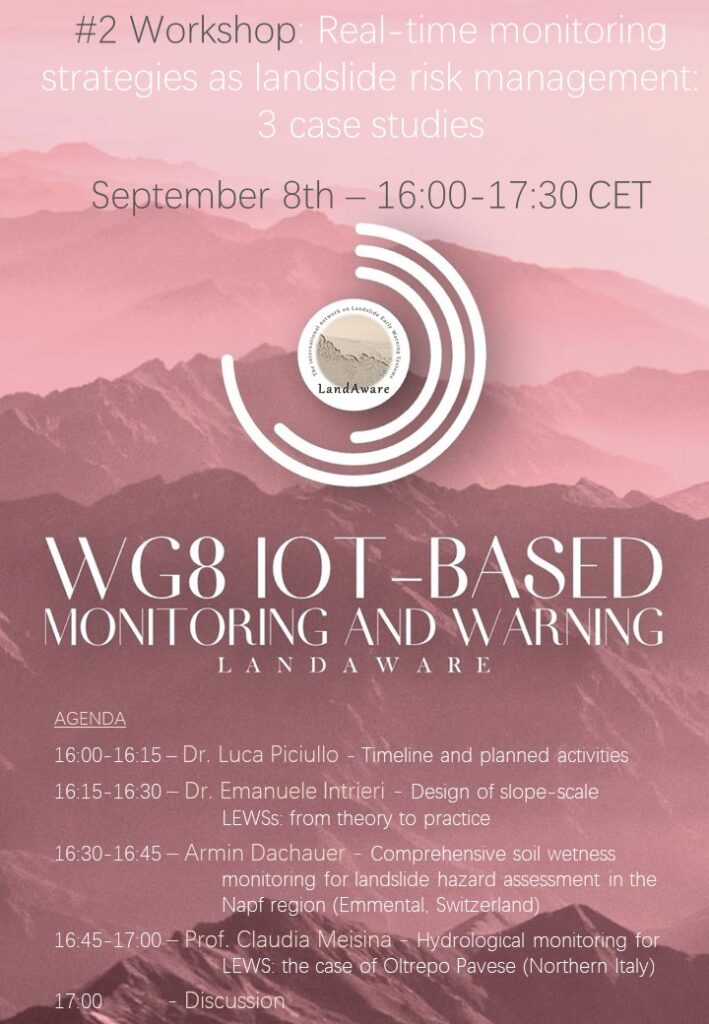The recordings of the TheHuT–WG8 joint workshop on “Real-time Monitoring Using IoT Technology“, held on May 7 2024, are online on the LandAware YouTube Channel.

The recordings of the TheHuT–WG8 joint workshop on “Real-time Monitoring Using IoT Technology“, held on May 7 2024, are online on the LandAware YouTube Channel.

NEWS received from
Luca Piciullo (NGI, Norway)
The next International Society for Soil Mechanics and Geotechnical Engineering (ISSMGE) – TC220 Field Monitoring in Geomechanics series of international lectures will take place on Friday 26th of January 2024 at 11:00 CET. It will be given by Dr. Luca Piciullo, with a lecture on “A fully operational IoT-based real-time slope stability analysis for an unsaturated slope in Norway”. This is the fifth in this very successful series of lectures.
The lecture will be introduced by Dr. Neelima Satyam.
To join the lecture, please use the following link: https://lnkd.in/g8Cn_W2D or scan the QR code.

News received from
Dylan Mikesell (NGI, Norway)
Fifth Workshop on Machine Learning with IoT data for the IoT-based methods and analyses Working group
Tuesday, April 11, 2023 – 16:00-17:30 CEST
NEWS received from
Luca Piciullo (NGI, Norway)
Joint Technical Workshop (WG8 & ISSMGE TC309) on Landslide Warning and Prediction using IoT and Machine Learning
February 23, 2023 09:00-12:00 CET
Teams Meeting ID: 331 710 067 783 – Passcode: V6tSh9
NEWS received from
Luca Piciullo (NGI Norway)
—–
Third Workshop on How to use IoT data in landslide modelling for the IoT-based methods and analyses Working group
December 1 – 16:00 – 17:30 CET time
Agenda
16:00-16:15 Dylan Mikesell (NGI, Norway) – Timeline and planned activities
16:15-16:30 Ben Mirus (USGS, USA) – Overview of USGS monitoring, modeling, and other research strategies for real-time situational awareness and landside warning
16:30-16:45 Luca Piciullo (NGI, Norway) – A first step towards a IoT-based local early warning system for an unsaturated slope in Norway
16:45-17:00 Roberto Greco (University of Campania, Italy) – Identification of Hydrological Controls for Improvement of Shallow Landslide Prediction in Pyroclastic Slopes of Campania
17:00 Discussion

Ben Mirus is a Research Geologist with the U.S. Geological Survey’s Landslide Hazards Program in Golden, Colorado. Ben applies his background in geology, hillslope hydrology, and numerical modeling towards developing new tools for landslide hazard assessment and loss reduction.
Luca Piciullo PhD at the University of Salerno, Italy, in Geotechnical engineering. Currently employed at the Norwegian Geotechnical Institute (NGI), Oslo, Natural Hazards division, in the section Slope stability and risk assessment. The technical and scientific work focuses on slope stability analysis, monitoring and risk mitigation with early warning systems, risk assessment of building damages due to deep excavations and tailings dams stability analysis.
Roberto Greco, Ph.D. in Hydraulic Engineering at Università di Napoli “Federico II” in 1997, professor of Hydrology and Hydraulic Infrastructures at Università della Campania “L. Vanvitelli”, teaching in the M.Sc. courses in Civil and Environmental Engineering. Since 2016, member of the Editorial Board of Hydrology and Earth System Sciences. The research activity deals with monitoring and modelling of water in natural and artificial systems, with specific focus on hillslope hydrology and landslides; preferential flows in unsaturated soils; environmental impact of sewer systems; management of water supply networks.
NEWS received from
Luca Piciullo (NGI, Norway)
If you are interested to have access to the past workshops material (presentations, recordings, flyers) please send an email to luca.piciullo@ngi.no
NEWS received from
Luca Piciullo (NGI Norway)
—–
Second Workshop on Real-time monitoring strategies as landslide risk management for the IoT-based methods and analyses Working group
September 8 – 16:00 – 17:30 CET time
Agenda
16:00 – 16:15 – Dr. Luca Piciullo – Timeline and planned activities
16:15 – 16:30 – Prof. Emanuele Intrieri – Design of slope-scale LEWSs: from theory to practice
16:30 – 16:45 – Armin Dachauer – Comprehensive soil wetness monitoring for landslide hazard assessment in the Napf region (Emmental, Switzerland)
16:45 – 17:00 – Prof. Claudia Meisina – Hydrological monitoring for LEWS: the case of Oltrepo Pavese (Northern Italy)
17:00 – 17:30 – Discussion

Prof. Emanuele Intrieri is an Assisting Professor at the Earth Sciences Department at the University of Florence. His research is mainly devoted to landslides monitoring and forecasting, with particular reference to slope stability threatening cultural heritage and the characterization of historical and heritage stone buildings affected by detachments. He is author or co-author of more than 50 scientific publications in international journals and of a number of conference proceedings and book chapters. He took part in several national and international research projects and to civil protection emergencies as team member of the Centre of Competence of the Italian Civil Protection Department and of the UNESCO Chair on Prevention and sustainable management of geo-hydrological hazards.
Armin Dachauer received his master degree in Atmospheric and Climate Science at ETH Zurich. He is currently working as research assistant at the Swiss Federal Research Institute WSL (Birmensdorf, Switzerland), where he is responsible for soil wetness stations in Central Switzerland.
Prof. Claudia Meisina received her PhD in Earth Sciences from the University of Pavia (Italy). Currently is associate professor in Engineering Geology at the Department of Earth and Environmental Sciences of University of Pavia, where she leads the Laboratory of Engineering Geology and she is member of the PhD School of Earth and Environmental Sciences. She has been a post-doc at the BRGM in France. She received fellowships through Italian Foreign Affairs Ministry and Centre International pour la Formation et les Echange Géologiques. She is actually involved in Liquefact Horizon 2020 Project and in several projects about the role of land use in shallow landslide triggering.
__________________________
NEWS received from
Luca Piciullo (NGI Norway)
—–
First Workshop on Seismic noise and Geophysical monitoring for the IoT-based methods and analyses Working group
July 5, 2022 — 16:00 – 17:30 CET
Agenda
———-
Dr. Eric Larose is a CNRS Director of Research at Joseph Fourier University in Grenoble, France. Eric is the Director of LABCOM, a joint industry-academia research partnership focused on developing innovative technologies and methodologies to monitor and predict natural and artificial instabilities. Eric has a history of transdisciplinary work related to natural hazard monitoring. His expertise lies in geophysics and seismology.
Dr. Jim Whiteleyis a geophysicist, with expertise in integrating seismic investigation methods with well-established electrical resistivity tomography monitoring methods. His research focuses on the application of these methods to monitor landslides, with an emphasis on establishing hydrogeological and geomechanical precursors to slope failure. He is currently employed at the British Geological Survey.
Dr. Malgorzata Chmiel is Postdoc at Swiss Federal Institute for Forest, Snow and Landscape Research (WSL). She is a geophysicist, with expertise in seismic data (ground vibrations) generated by mass movements and ambient noise sources. Her research focuses the application of machine learning to natural hazards (e.g., debris flow detection with machine learning and seismic data).
NEWS received from
Emir Ahmet Oguz – NTNU, Norway
Our new paper “IoT-based hydrological monitoring of water-induced landslides: a case study in central Norway” was published on the Bulletin of Engineering Geology and the Environment.
This study presents an overview of a case study on IoT-based hydrological monitoring of water-induced landslides in central Norway and highlights several important findings on the implementation of IoT-based monitoring systems. The collected data on hydrological activities in terms of volumetric water content and matric suction provided novel and valuable insights into the hydrological responses of slopes in seasonally cold climates.
Our paper was published with open access and feel free to read this study!
Link: https://link.springer.com/article/10.1007/s10064-022-02721-z